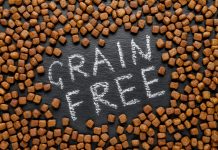Micronutrients
Vitamins and minerals are considered micronutrients, since they don’t make up an appreciable amount of the bulk of your dog’s food.
However, these small amounts of chemicals make a huge difference in the health of your dog.
As a general rule, as long as you’re good about the ingredients contained within your dog food and your dog is healthy, your pet will be healthy. If you have to opt for cheaper food, or if your dog has some kind of health problem preventing proper metabolism of a nutrient, however, you’ll want to make sure that you supplement.
While it’s not quite as important to understand as macronutrients, understanding a little bit about vitamins and minerals can help you to make sure that you notice if any deficiencies happen.
Minerals
Minerals are generally had in the form of inorganic salts, which really doesn’t mean much to most of us. The important part is that they’re present in the correct amounts since too much either way can end badly for your poor dog.
One of the worst offenders in this area is calcium.
Calcium is necessary for growing dogs, since it supports both their dentition and their bones as they get older but too much of it has the potential to cause skeletal abnormalities. This is particularly common in large dog breeds, so be careful not to over-do it if you’re supplementing.
The main culprit of low calcium is actually a 100% meat diet. Remember how we were saying that dogs are omnivorous?
Most foods are mineral supplemented so this isn’t a primary concern, but if you’re feeding a homemade diet then you’re going to want to ensure that there are vegetables in their diet as they’re the main source of minerals.
If you opt to do this, then you need to keep in mind that raw vegetables are harder to digest, but more nutrient dense, while the opposite is true if you lightly cook the vegetables. You can also put them in a blender and mix them in with the rest of the food you’re planning on feeding for a healthy compromise.
For the most part, mineral deficiencies will cause a dog to stop growing. If you notice that your dog has suddenly stopped gaining weight and size before their time, then you may want to take a closer look at their diet.
Vitamins
Just like their owners, dogs need to make sure that they get a good amount of vitamins. They come from diverse sources and aren’t supplemented in foods quite as often as minerals although even cheap foods will usually have some boost to their natural components.
The most studied deficiency in our canines is Vitamin A. It’s not likely to happen if you feed a good diet, since meat contains a good portion of it, but it can lead to motor and vision impairment, skin lesions, and all kinds of fun stuff.
Whereas minerals will often cause developmental difficulties, you’re going to be looking at some serious health problems emerging if a dog is vitamin deficient. Any kind of serious deficiency is likely going to require veterinary intervention but lethargy, losing hair, and skin problems are all likely signs that you may want to take a closer look at the diet.
Supplementation
There’s a pretty large market in dog supplements, and it’s ever growing as dogs aren’t quite adapted to the more laid-back modern life and people seem to think it’s a great way to help them lose weight instead of simply feeding less.
Even the lowest-quality dog food isn’t usually going to cause any kind of nutrient imbalance bad enough to require intervention. We don’t recommend supplementing vitamins and minerals unless your vet specifically tells you to do so. There are risks to some dogs and very little benefit to most.
However, there are some supplements which are quite useful.
Glucosamine-Chondroitin supplements are great for dogs who suffer from osteoarthritis. These compounds have been shown to increase mobility and reduce pain levels in suffering canines.
Fatty acid supplements have also been shown to improve hair and skin health for canines, and if you can afford them they’re generally a good idea for any dog who doesn’t have a compromised pancreas.
Other than those two, you should probably stick with what the vet recommends and always consult with them before you decide to land your dog on something. If you insist, herbs and amino acids are generally safe to utilize for your dog, but be extremely wary of supplementing vitamins or minerals without a vet’s direct recommendation.
Recap
We know this was a lot of information to take in, so let’s go over the most important points of dog nutrition one more time:
- Macronutrient balance is probably the most essential part of your dog’s diet. At least 25% protein and 25% fat is ideal.
- Protein sources are more important than the raw crude protein amount. Meat and eggs provide the most usable protein for your pet.
- Carbohydrates are pretty much filler but the sources are important in making sure your dog gets their proper micronutrient balance.
- Mineral deficiencies generally cause growth problems, serious vitamin deficiencies will present as health problems so watch your dog carefully.
- Supplementing vitamins and minerals is risky, but fatty acids can help with their coat and skin while glucosamine is ideal for dogs with inflammation problems resulting from arthritis.
- Most commercial foods use low-quality ingredients and a bad balance, which means you need to take your research very seriously if you’re looking to keep your dog in optimal health.



























